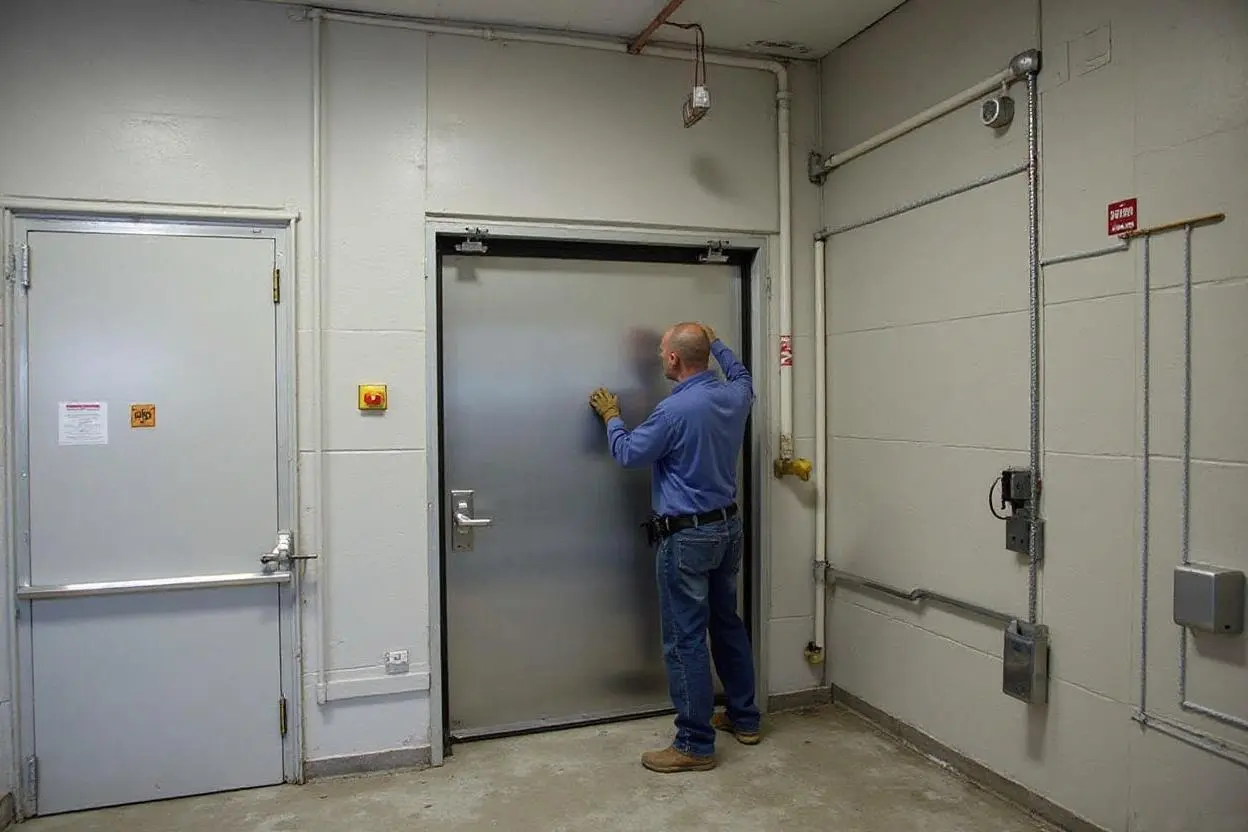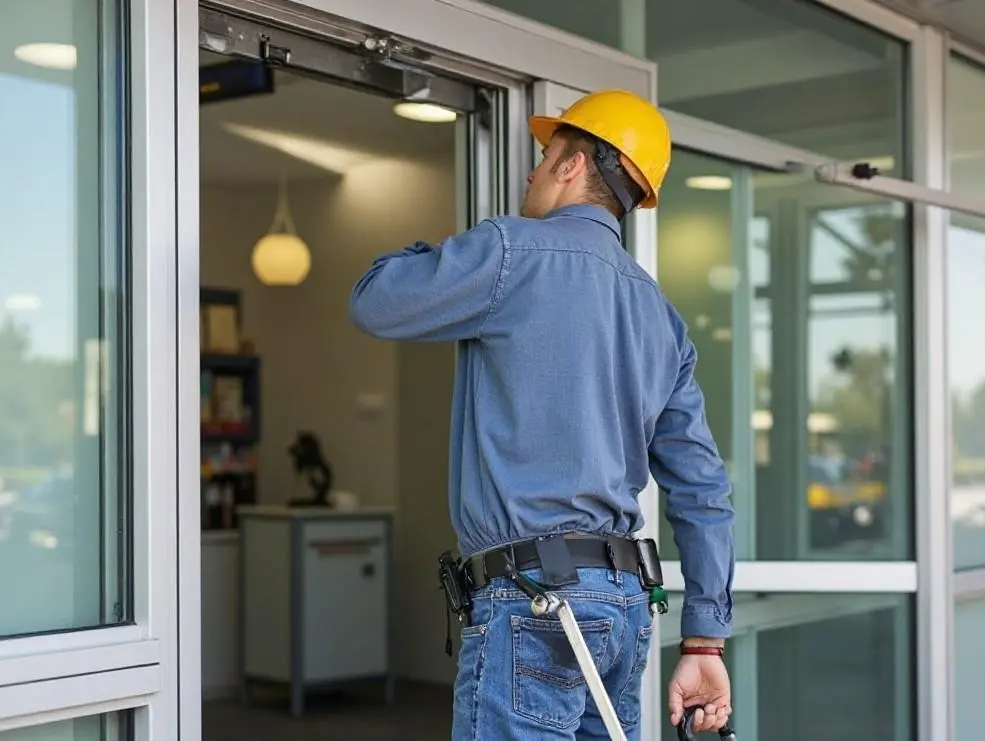Automatic Door Safety Sensors: Preventing Accidents in High-Traffic Areas
Automatic doors move fast, and people rarely slow down for them. In busy Buffalo entrances — Elmwood Village shops, Maple Road medical offices, hotels near the airport, and hospitals on the East Side — a missed sensor or a slow controller can turn a smooth entry into a shoulder bump or stroller snag. Safety sensors prevent that. They “see” people and carts, confirm a clear threshold, and delay door movement until it is safe. A strong sensor plan reduces liability, keeps traffic flowing, and cuts downtime.
This is where regular inspection and precise calibration matter. Many calls for automatic sliding doors repair in Buffalo trace back to a dirty lens, a misaligned curtain, or a controller set to the wrong hold-open time for the season.
What modern safety sensors actually do
Most sliding systems use a mix of detection technologies. Overhead presence sensors watch the swing zone and threshold. Side-screen or header-mounted active infrared curtains protect the leading edge and keep the door from closing on someone standing still. Microwave radar triggers the initial opening as moving traffic approaches from the lobby or sidewalk. On interior packages, light curtains run vertically along the opening to catch legs, canes, and low carts where traditional sensors can miss.
Each technology has strengths. Microwave picks up motion and works well for fast traffic, but it can miss a person who stops under the header. Infrared detects presence at low speed or stationary, but sunlight and reflective floors can cause false reads. A smart setup blends both and sets the field size for the doorway width and approach speed common to that site.
Why high-traffic Buffalo entrances need more than a factory default
Factory defaults assume mild weather and moderate flow. Buffalo does not give that. Salt film in winter dulls sensor lenses. Heavy parkas and hats reduce motion signatures. Bright snow glare at the threshold can wash out infrared. Revolving door vestibules trap heat; sliding doors on the exterior see wind gusts off Lake Erie that move mats and trigger false openings. Each factor affects detection.
On a Main Street retail entrance that sees 800 to 1,200 passes per day, the team often widens the presence field and extends hold-open time during winter by 0.3 to 0.5 seconds. In medical clinics where patients pause at the threshold, they add a vertical light curtain to catch stationary presence within 4 to 6 inches of the closing edge. For grocery stores in North Buffalo, side screens that project into the opening by 2 to 4 inches protect carts with kids riding up front.
Typical accident scenarios and how sensors prevent them
A common event is the “hesitant step.” Someone approaches, the radar opens the door, they pause to check a phone, then the controller starts to close. Without an active presence field set close to the floor, the panel can nudge a heel or walker. A properly aimed infrared curtain and a bottom beam at 8 to 10 inches stop the close and reset the timer.
Another event is “shadow detection.” In late afternoon, sunlight throws long shadows across a glossy floor. The sensor reads the contrast as movement and keeps the door open. That wastes energy and strains rollers. Shielding the sensor, adjusting sensitivity, and using polarized lenses solve it.
Less frequent but serious is “tailgating closure.” Two people walk through with a gap. The first clears the presence zone; the second is still in the opening when the door begins to close. A dense light curtain or extended presence field with overlap across both panels catches the second person and holds the door.
How to tell the problem is sensor-related
Most building teams in Buffalo call for automatic sliding doors repair after seeing one of three symptoms: doors close on a slow-moving person, doors stay open for too long without traffic, or doors fail to open until a person is very close. Those signs point to alignment, sensitivity, or field-size issues. Dirty lenses create late openings. Misalignment causes narrow “dead zones.” Controller settings out of sync with the site cause hold-open or reactivation problems.
A quick field check helps. Walk slowly through the opening and stop under the header for two seconds. The door should not attempt to close. Roll sliding door an empty cart across the threshold at one foot per second. The door should open before the front wheels reach the beam and remain open until the rear wheels clear. If either test fails, schedule service.
What local codes and standards expect
Most commercial sliding doors follow the current ANSI/BHMA A156.10 standard and any New York State building code overlays. The standard calls for approach sensors, threshold protection, and reactivation zones that cover the full travel path. For healthcare facilities, extra presence detection at low height is common practice. Insurance carriers often require semiannual inspections with documentation. In Buffalo, many property managers align these checks with seasonal maintenance — pre-winter and spring — to account for salt, ice, and grit.
Maintenance patterns that prevent accidents
Sensors are electronics exposed to dust, condensation, and human traffic. Simple steps avoid service calls and injury risk.
- Weekly: wipe lenses with a soft cloth and a non-abrasive cleaner, check that floor mats are flat and secured, and remove salt buildup from winter entryways.
- Monthly: walk-test approach speed from both sides, verify hold-open time matches real traffic flow, and confirm the bottom beam or light curtain catches low profiles like canes or small carts.
Contractor tip: do not spray cleaner directly on the sensor. Spray the cloth and wipe. Liquid can seep into the housing and fog the lens. For sites near the waterfront or snow belt, consider a sensor with heated lens or a shroud to reduce condensation and glare.
Repair versus recalibration: choosing the right fix
Not every “bad” sensor needs replacement. If the door opens late but passes a static presence test, recalibrate the radar range and angle first. If the door closes on a stationary person, adjust the infrared curtain density and extend the field by a few inches. Replace sensors that show intermittent output, cracked housings, or repeated false activations after cleaning and alignment. In many Buffalo sites, the team sees sensors reach end of life at 7 to 10 years, sooner for doors facing heavy weather.


For legacy systems without light curtains, adding a secondary presence device often costs less than one injury claim. It also helps pass modern safety audits when tenants change or traffic increases.
Why site conditions drive settings
A downtown office tower with polished terrazzo floors needs lower IR sensitivity to avoid reflections, while a neighborhood clinic with rubber flooring can run a denser field. A wide storefront on Hertel Avenue benefits from staggered radar zones so the door starts to open earlier for people pushing strollers from a side approach. Hospitals near Buffalo General often need redundant protection at 4 to 6 inches above the floor to cover IV poles and footrests on wheelchairs. These are judgment calls made on site, not from a manual.
Winter-specific adjustments that pay off
Cold months change everything. Coats and scarves reduce detectable motion; doorways see slush and salt; sunlight glare increases. Many facilities switch to a “winter profile”: increase approach sensitivity slightly, extend hold-open time by a fraction of a second, and tighten the threshold presence field so it sits closer to the floor. A simple matte runner at the threshold can cut IR washout by breaking up reflections. Plan a mid-season check in January when salt and grit peak.
The cost of getting it wrong
Beyond injury risk, poor sensor performance slows traffic and frustrates customers. A door that hesitates costs seconds per entry; across 1,000 daily passes, that adds up to staff time and lost sales. False open events cycle operators and wear rollers and belts. Energy loss from doors stuck open shows up on heating bills. These are avoidable with small, precise corrections.
Why Buffalo calls A-24 Hour Door National Inc.
The service team works on automatic sliding doors repair in Buffalo across grocery chains, healthcare, higher education, and mixed-use buildings. They carry common sensors, light curtains, and controllers on the truck, and they understand how local weather skews detection. Most calls include a safety audit, on-the-spot cleaning and alignment, and written settings so property teams know what changed.
Property managers value clear communication: what failed, why it failed, what was adjusted, and what to watch next season. The crew schedules work off-hours for busy entries and coordinates with security so access stays controlled during testing.
A quick owner checklist before calling
- Confirm power and breaker status, then cycle the controller once to clear a lockup.
- Inspect and clean sensor lenses gently, remove salt and dust, and flatten mats.
- Walk-test slow and stop under the header; roll-test a cart; note exactly where the door misbehaves.
If any test fails, or if the door touched a person, stop using it and request service. Safety issues do not wait.
Ready support for safer entrances
Safe doors keep traffic moving and liability low. Properly configured sensors make the difference between a near miss and a smooth entry. For reliable automatic sliding doors repair in Buffalo, A-24 Hour Door National Inc. responds quickly, sets sensors for real site conditions, and documents every change. Call to schedule a safety inspection, request a same-day repair, or plan seasonal recalibration for your entrances in Downtown, North Buffalo, Amherst, Cheektowaga, and Tonawanda.
A-24 Hour Door National Inc provides commercial and residential door repair in Buffalo, NY. Our technicians service and replace a wide range of entry systems, including automatic business doors, hollow metal frames, storefront entrances, fire-rated steel and wood doors, and both sectional and rolling steel garage doors. We’re available 24/7, including holidays, to deliver emergency repairs and keep your property secure. Our service trucks arrive fully stocked with hardware, tools, and replacement parts to minimize downtime and restore safe, reliable access. Whether you need a new door installed or fast repair to get your business back up and running, our team is ready to help. A-24 Hour Door National Inc
344 Sycamore St Phone: (716) 894-2000 Website: https://a24hour.biz/buffalo
Instagram: @a24hourdoor
Buffalo,
NY
14204,
USA
Facebook: 24 Hour Door
Yelp: A-24 Hour Door National (Buffalo)
X (Twitter): @a24hrdoor